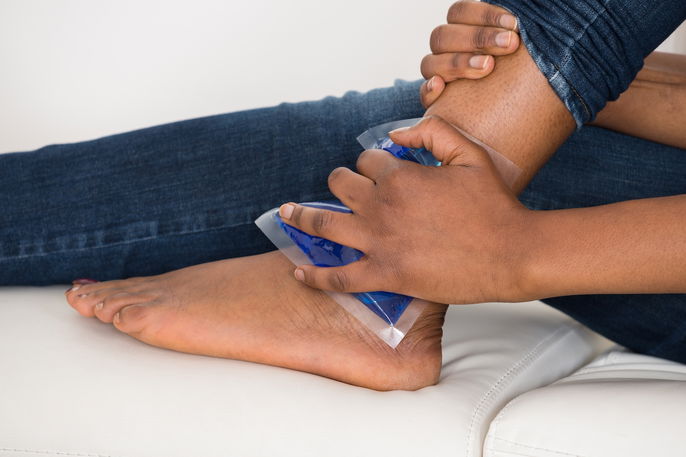Sprained ankle treatment can be completed at home when the sprain is mild. Recovery takes about 7 to 15 days, and treatment is aimed at reducing pain and swelling.
When you sprain your ankle by twisting it or falling, you can injure the ankle ligaments and even fracture nearby bones. In these cases, as well as swelling and pain, you may find it difficult to walk or weight bear on the injured foot.
Although sprains can be treated at home in most cases,you should still see medical attention, particularly if you are unable to step on the foot or if you feel pain with palpation.

How to treat a sprained ankle
You can use the following measures to help speed-up the recovery of a sprained ankle:
1. Keep your foot elevated
It is recommended that you keep your foot elevated to prevent swelling from getting worse. You can lie on a bed or sofa and place a high pillow under the injured foot.
2. Apply an ice pack
Applying ice compresses or even bags of frozen vegetables to the affected area for 15 minutes at a time can help relieve pain and swelling. It's important to place a thin towel or diaper between the skin and the compress to prevent the cold from burning the skin.
3. Wiggle your toes
Wiggling your toes little by little can facilitate recovery and reduce swelling.
4. Do gentle stretches with your ankle
Performing light stretches can help improve blood circulation and range of movement.
How long recovery takes
Mild injuries can take between 7 and 15 days to fully heal. However, when the injuries are more serious and present with bruising, swelling or difficulty walking, the recovery time can take up to a month and a short period of immobilization, rehabilitation through physiotherapy or walking aids may be necessary.
In addition, some cases may continue to experience pain, swelling and difficulty walking despite treatment and may require surgery.
When to see a doctor
It is important to seek urgent medical attention if you experience any of the following:
- Immense difficulty walking or inability to support weight bear on the injured foot
- Pain to the touch in the affected ankle;
- Sensation of small pops when you palpate the ankle;
- Numbness in the foot;
In these cases, the injuries can be more serious, with a risk of fracture or ligament rupture, and home treatment is not enough. Therefore, you should proceed to the nearest emergency room for assessment.
In addition, when pain and swelling in the ankle or difficulty walking continue even after treatment, it is important to consult an orthopedic surgeon, who is the most appropriate professional to assess the injury and indicate the best form of rehabilitation.






























